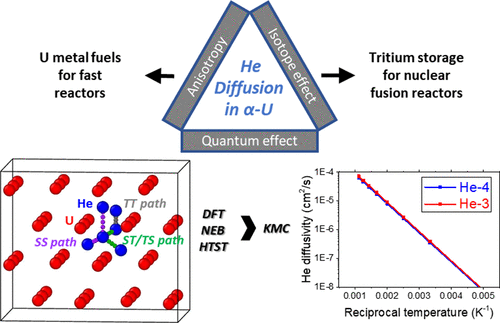当前位置:
X-MOL 学术
›
J. Phys. Chem. C
›
论文详情
Our official English website, www.x-mol.net, welcomes your
feedback! (Note: you will need to create a separate account there.)
First-Principles Calculations of the Diffusivity of Interstitial Helium in Alpha-U Considering Anisotropy, Isotope Effects, and Quantum Effects
The Journal of Physical Chemistry C ( IF 3.3 ) Pub Date : 2021-09-21 , DOI: 10.1021/acs.jpcc.1c04053 Jae-Hyuk Kim 1 , Jae-Uk Lee 2 , Min Ho Chang 2 , Takuji Oda 1
The Journal of Physical Chemistry C ( IF 3.3 ) Pub Date : 2021-09-21 , DOI: 10.1021/acs.jpcc.1c04053 Jae-Hyuk Kim 1 , Jae-Uk Lee 2 , Min Ho Chang 2 , Takuji Oda 1
Affiliation

|
The interstitial migration of helium in alpha-U, which is planned to be used as a tritium storage material for nuclear fusion reactors and as a metallic fuel for advanced nuclear reactors, is studied by first-principles calculations. First, all migration paths are identified using the nudged elastic band method, and the migration barrier is determined for each path considering the thermal expansion of the lattice. In addition, the jump attempt frequencies are determined by applying harmonic transition state theory coupled with vibration analysis. Subsequently, the diffusion coefficient is evaluated numerically by kinetic Monte Carlo calculations using the determined migration barriers and jump attempt frequencies for all migration paths. Diffusion in the [010]-direction is found to be the most unlikely until sufficiently high temperature, while [001]-diffusion is the most dominant diffusion direction through the whole temperature range. The isotope effect, which is important because the beta decay of tritium produces helium-3, is not large and approaches the classical limit as the temperature increases. The quantum tunneling crossover temperature is computed to be approximately 100 K for helium-3 and 86 K for helium-4, which ensures the validity of the present calculation results over a wide temperature range. The diffusion coefficients are obtained as  for helium-3 and
for helium-3 and  for helium-4 over a temperature range from 200 to 900 K.
for helium-4 over a temperature range from 200 to 900 K.
中文翻译:

考虑各向异性、同位素效应和量子效应的 Alpha-U 中间隙氦扩散率的第一性原理计算
通过第一性原理计算研究了计划用作核聚变反应堆氚储存材料和先进核反应堆金属燃料的 alpha-U 中氦的间隙迁移。首先,使用微调弹性带方法识别所有迁移路径,并考虑晶格的热膨胀为每个路径确定迁移障碍。此外,跳跃尝试频率是通过应用谐波过渡态理论与振动分析相结合来确定的。随后,使用确定的迁移障碍和所有迁移路径的跳跃尝试频率,通过动力学蒙特卡罗计算对扩散系数进行数值评估。发现在 [010] 方向上的扩散是最不可能的,直到足够高的温度,而[001]-扩散是整个温度范围内最主要的扩散方向。同位素效应很重要,因为氚的 β 衰变会产生氦 3,它并不大,随着温度的升高接近经典极限。计算出的量子隧道穿越温度对于氦 3 约为 100 K,对于氦 4 约为 86 K,这确保了当前计算结果在很宽的温度范围内的有效性。扩散系数为 计算出的量子隧道穿越温度对于氦 3 约为 100 K,对于氦 4 约为 86 K,这确保了当前计算结果在很宽的温度范围内的有效性。扩散系数为 计算出的量子隧道穿越温度对于氦 3 约为 100 K,对于氦 4 约为 86 K,这确保了当前计算结果在很宽的温度范围内的有效性。扩散系数为 氦 3 和
氦 3 和 氦 4 在 200 到 900 K 的温度范围内。
氦 4 在 200 到 900 K 的温度范围内。
更新日期:2021-09-30
 for helium-3 and
for helium-3 and  for helium-4 over a temperature range from 200 to 900 K.
for helium-4 over a temperature range from 200 to 900 K.
中文翻译:

考虑各向异性、同位素效应和量子效应的 Alpha-U 中间隙氦扩散率的第一性原理计算
通过第一性原理计算研究了计划用作核聚变反应堆氚储存材料和先进核反应堆金属燃料的 alpha-U 中氦的间隙迁移。首先,使用微调弹性带方法识别所有迁移路径,并考虑晶格的热膨胀为每个路径确定迁移障碍。此外,跳跃尝试频率是通过应用谐波过渡态理论与振动分析相结合来确定的。随后,使用确定的迁移障碍和所有迁移路径的跳跃尝试频率,通过动力学蒙特卡罗计算对扩散系数进行数值评估。发现在 [010] 方向上的扩散是最不可能的,直到足够高的温度,而[001]-扩散是整个温度范围内最主要的扩散方向。同位素效应很重要,因为氚的 β 衰变会产生氦 3,它并不大,随着温度的升高接近经典极限。计算出的量子隧道穿越温度对于氦 3 约为 100 K,对于氦 4 约为 86 K,这确保了当前计算结果在很宽的温度范围内的有效性。扩散系数为 计算出的量子隧道穿越温度对于氦 3 约为 100 K,对于氦 4 约为 86 K,这确保了当前计算结果在很宽的温度范围内的有效性。扩散系数为 计算出的量子隧道穿越温度对于氦 3 约为 100 K,对于氦 4 约为 86 K,这确保了当前计算结果在很宽的温度范围内的有效性。扩散系数为
 氦 3 和
氦 3 和 氦 4 在 200 到 900 K 的温度范围内。
氦 4 在 200 到 900 K 的温度范围内。











































 京公网安备 11010802027423号
京公网安备 11010802027423号